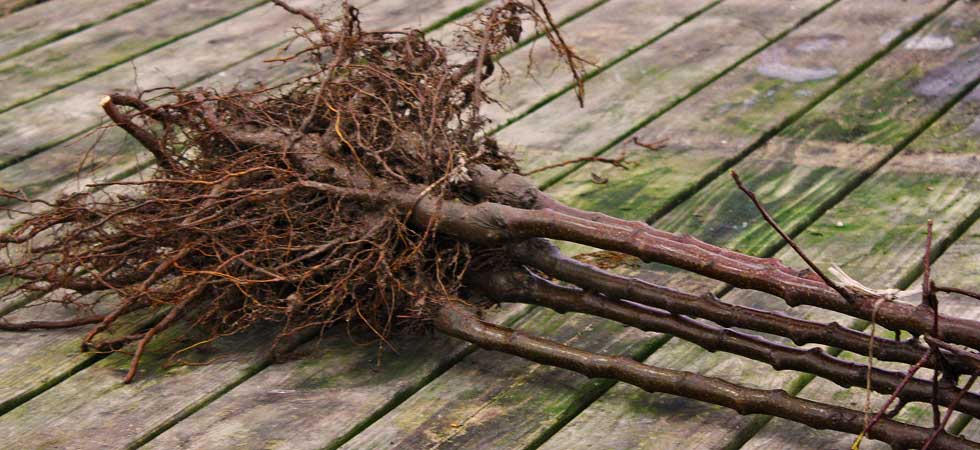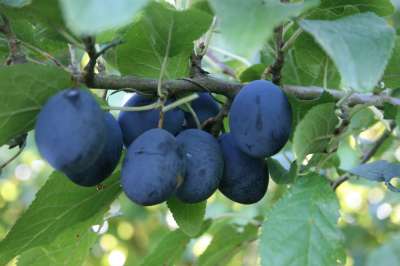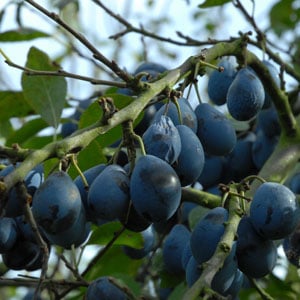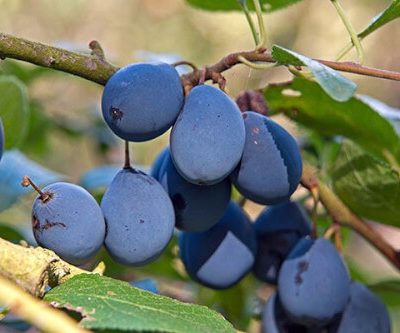Your basket is currently empty!
Growing Damsons in containers
Select from a complete range of Damson trees for sale here.
Provided you choose the Pixy rootstock it is entirely permissible to keep your Damson tree in a pot. I recommend a 24” container and a loam based potting compost for these trees. John Innes no 2 is good, or whatever you can get that is similarly loam based. Additional feed can be given once the tree is established. We use Osmocote tablets here on the Nursery because a single application lasts the whole season. Miracle grow or even tomato feed can be given as alternatives. Pruning will be based on the instructions for bush trees grown in the open ground but there will be less growth to deal with so keep pruning on the light side.
After 5 years you can re pot your Damson tree – either in a container 4-6” bigger, or remove some of the spent compost from the rootball and re-plant in the same container with fresh compost. The latter method is best undertaken during the winter months.
When to plant Damson trees
Traditionally this has always been undertaken during the winter months. The trees are dormant then and receive less shock and usually come away quickly in the Spring. For winter planting you will be using a bare rooted tree, one that has been dug up from the field or nursery bed after the leaves have fallen and the tree is asleep. As long as the tree is dealt with quite quickly this is the most satisfactory method and frost and snow won’t harm he tree at all once it is in the ground. If you can’t plant it straight away it should be kept with the roots in a sealed polythene bag to keep them moist, and placed somewhere cool like a shed or garage. Never keep dormant trees indoors near to a source of heat. Alternatively you can pot the tree roughly into a big bucket of damp compost and place it in a shed, or the sheltered corner of the garden. It can then wait until you are ready to plant it. The main thing with bare root trees is to never allow the roots to dry out before it is planted.

Perhaps you weren’t ready to plant your Damson tree overwinter, or you have only just had the idea to plant one and outside the sun is shining and the birds are building their nests. Fear not, if you’re impatient to get going you can still plant a tree. That wonderful modern invention the container grown tree comes to you aid and allows for planting right through the Spring and summer. The only difference is you will be tied to the end of a hose pipe for a few weeks afterward as planting at this time requires consistent and regular watering on your part to keep the tree happy until it has put new roots down into the soil. Apart from that there are no disadvantages and usually the tree will establish well and be in a good position by the time it’s first winter arrives.
Soil preparation & planting
The ground should be well cultivated beforehand and the planting area where the holes should be double dug over. The reason this is necessary is because cloddy rough ground is difficult to work with, you need to make sure that when the tree is planted to soil fills the hole properly with no air cracks and this is difficult if you are working with great lumps of soil.All weed growth should of course be removed.
An application of fertilizer should be incorporated into the soil; a 2ox sprinkling of grow more is ideal nicely worked into the ground. Planting can take place at any time during Winter as long as the soil is workable and you do not need to delay if frost is forecast because the trees will be impervious once they are in the ground again. You should not leave the trees laying about on the surface of the soil overnight ‘though because the roots should not be subject to frost when they are exposed, but once they are planted in the soil again it doesn’t matter.
Drive the stake – a 48” 2 x 2” take should suffice – into the hole before planting; the stem of the tree should be about 2” away. Column trees will not need such a substantial stake – a standard rose stake, or a stout bamboo cane is sufficient.
Make sure the hole is large enough for the roots – this is why it is inadvisable to dig the hole in advance because you don’t know for sure how big the roots of the tree will be before you get it. Place the tree in the hole with the roots well spread out and not bent to get them in. Fill in with the prepared top soil and firm down well. The soil should now be level with the surface of the surrounding ground. Water in gently, allow it to settle, and then place some more soil on it to bring it back up as by this point it will probably have sunk a little. With bare root trees there should be no need to water further.
Place a tree guard around the trunk unless you garden in town or a very urban area; rabbits and deer are very partial to chewing the bark. A Spiral tree guard is the simplest and most cost effective way of protecting young fruit trees from vermin damage.
Pot grown trees are planted in the same way with the hole for the rootball being approximately the same. Plant to the level of the top of the pot and water heavily – with a hose, applied direct to the roots and immediately surrounding area. Repeat morning and evening for the next 2-3 weeks and thereafter once a day until established and the tree shows no further signs of stress. Extra irrigation should be provided on an as-needed basis until the Autumn depending on “”the weather”” !
Planting against a wall
Be wary that the soils isn’t dry because it very often is in such situations. If necessary irrigate the soil regularly for some weeks before planting, as well as after. When planting the stem of the tree should ideally be about 18” away from the wall. You can tilt it slightly towards the supporting wires on planting if necessary. The support system should be in place before you plant the tree.Sometimes it is more practical to install an automated irrigation system – quite simple and non costly methods are available – to ensure the tree gets adequate water and this is an especially good idea if you have multiple trees in place. The trouble with planting against wall or fence is that they are so often sheltered from prevailing rain and this needs to be counteracted on a consistent basis to ensure the well being of your tree.






